by Tom Gaylord
Writing as B.B. Pelletier
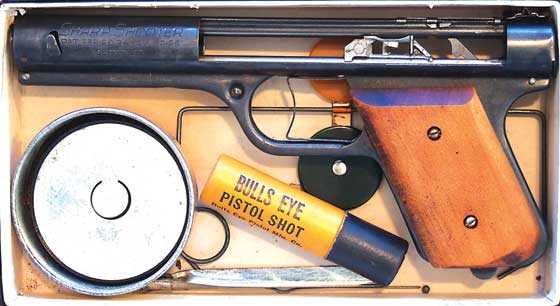
The Sharpshooter catapult pistol was made from the early 1930s until the 1980s by as many as 5 different companies. This one was made in the early 1940s.
This report covers:
- Bulls Eye pistol
- Sharpshooter velocity
- The launcher
- Velocity
- One band
- Chronograph problems
- Discharge sound
- Trigger pull
- Accuracy
- Next time
Before we begin, I want to share an email I received last Friday. It says a lot about the experience of attending the Pyramyd AIR Cup.
“Hi Tom,
Meeting you in person for me was one of the highlights of the Pyramid Air Cup 2018. I’m the tall guy shooting any tournament for the first time. I shot a TX200 and had questions about a second air rifle that weekend. We spoke about the Sig P938 and you recommended a Sig 365 you were testing. I wanted to give you my perspective of what I got out my first shoot and ask you to consider sharing my thoughts. Not the shoot but as a newcomer into competition.
I went with no intention of shooting only the hope I might be able to shoot or learn by watching. I had only had my rifle for a few weeks. Everywhere I turned people (fellow Shooters) were wanting to share their wisdom on what I was doing wrong. In every case this advise were things I never thought about. Things like placement of my equipment while sitting down to shoot, consistency on how I placed the riffle on the sticks, in what order I should prepare myself for each shot, waiting on the wind, using my elbows on my knees to hold more securely, improving my artillery hold with my springer, staying hydrated and nutrition to stay less shaky, how to practice before tournaments, just to name a few.
Bottom line is there is no way I could practice enough without the wonderful advice I got at my very first shoot. Now that I have this shoot under my belt I feel I’m prepared to increase my shooting skills at a rate that would be impossible without this first shoot. The 6 hour drive one way was the best investment in my new shooting quality I’ve ever made!
Something else I took away was that my equipment was more than capable of getting a respectable score. I’m the only thing holding me back. I did not have a sighting card to help me remember where to hold for the different distances. I did not understand how much drift my pellet had under different wind conditions. These things I never ever considered. As I practice now I have a totally different mindset because of my experience which I almost didn’t get. On Friday night a shooter came up to me at the hotel parking lot I had met that morning and said to me “You Don’t Know What You Don’t Know. Get in there and Shoot no matter your preparedness or lack there of. You’ll learn how to practice.” Truer words could not have proven to be true.
I’m asking myself how I could help others to get in there and try it. The only thing I could think of is to write you, the most respected name in the air gun industry, and encourage others to give it a go. Maybe encourage other shoot organizers to figure out a way to handle more newcomers who just show up like I did. I don’t know how to change things to make this happen but maybe you do.
Also I noticed that the Demo Equipment was made for newcomers into the air gun world. 95% of the people there had way more than $1,000.00 invested in their rifle setup. Why didn’t they have demo equipment to match their primary audience/clientele?
Thanks again for all you do for the air gun industry. I hope to run into you again.”
I responded to his questions and I also forwarded his message to the event organizers Tyler Patner and Kristen Koss, and to Val Gamerman, the president of Pyramyd AIR. This man is right when he says it is worth the long drive, because you will see things and learn things you cannot get from just reading the internet. I hope you take his remarks to heart. Okay, on to my report.
Today I will begin testing the velocity of the Sharpshooter rubber band catapult gun. I intend going into far more depth in this report series than normal, so this is just the start of velocity testing. And I am standing on the shoulders of a giant!
Back when my wife and I published Airgun Revue magazine, we had many guest writers. Dean Fletcher was one of them and he approached us about an article he wanted to write on the Sharpshooter pistols. We agreed and he gave us an in-depth look at not only the history of the guns, but also the possibilities for velocity and accuracy. I learned most of what I know from Dean’s research.
Bulls Eye pistol
Dean started his history with the Bulls Eye pistol that was invented, produced and marketed by Dr. C.L. Bunten, a dentist in Rawlins, Wyoming. According to Dean, the Bulls Eye was available from 1925 to 1940. Other sources I cannot locate have given the starting date of 1923, which is the date I always use in print. Either way, that timeframe is when the Bulls Eye was available.
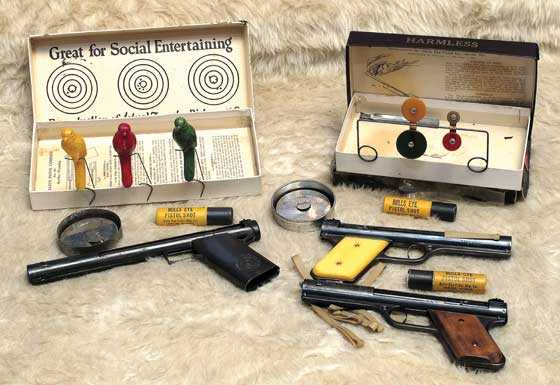
The Bulls Eye pistol on the left was the start of it all. From the mid ‘20s until 1940 this gun was sold as a package that’s seen here. You can compare the size to the shorter Sharpshooter pistols on the right.
I’m not going to report on everything about the Bulls Eye pistol because this article would quickly become too large. But it is a great place to begun talking about velocity. Fletcher discovered through experimentation that, by using multiple rubber bands to power the same type of catapult launcher that the Sharpshooter pistol has, the longer Bulls Eye pistol could get up to 195 f.p.s. for one number 6 birdshot. That was the fastest velocity he recorded. The average velocity for the gun set up that way, with 4 rubber bands powering the launcher, was 192 f.p.s. That should tell you how very consistent this type of gun is, and because of that I will be testing the Sharpshooter pistols differently. We don’t need 10-shot strings when the velocity seldom varies by three f.p.s.
Sharpshooter velocity
Dr. Bunten also developed the first Sharpshooter pistol, which he sold from Rawlins, as well. Using the same testing regimen, Fletcher got a Sharpshooter pistol up to an average 158 f.p.s. when five rubber bands were used. He did multiple tests with different types of rubber bands and found that sometimes adding more bands decreased velocity. Here is my analogy. An M1 Abrams tank engine develops 1,500 horsepower, yet the tank cannot accelerate as fast nor go as fast as a Honda motorcycle that has only 20 horsepower. Acceleration and velocity depend on several things besides horsepower or the number of rubber bands.
The launcher
Dean gave us a splendid graphic of the catapult launcher that explains how it works. Let’s look at it now.
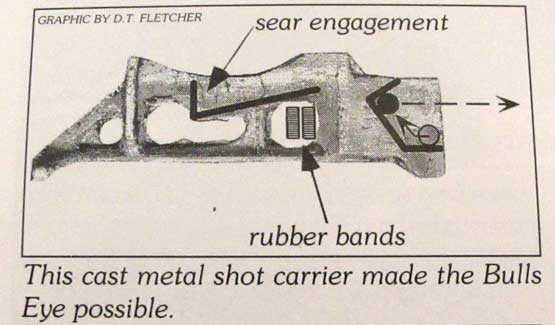
In the graphic, which I have enlarged, you can see how the shot climbs in its seat when the gun fires. That is a key to the accuracy.
It’s difficult to see in the graphic, but the “feet” of the launcher, front and rear, top and bottom, are curved to fit the rails they ride on. Here is a more detailed shot of an actual launcher.
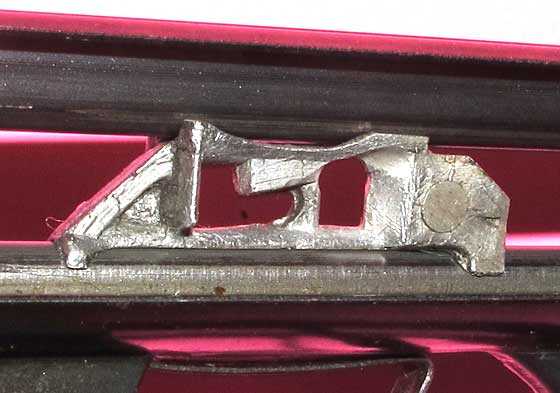
This image shows the cast metal launcher feet that grab the rails of the pistol, top and bottom.
The fit of the launcher to the rails can be controlled to a limited extent by spreading or squeezing the top rail away from or closer to the bottom rail. Of course the tighter the fit the greater the friction, and friction is an enemy of velocity. Here is another look at the rails from the muzzle end of the gun.
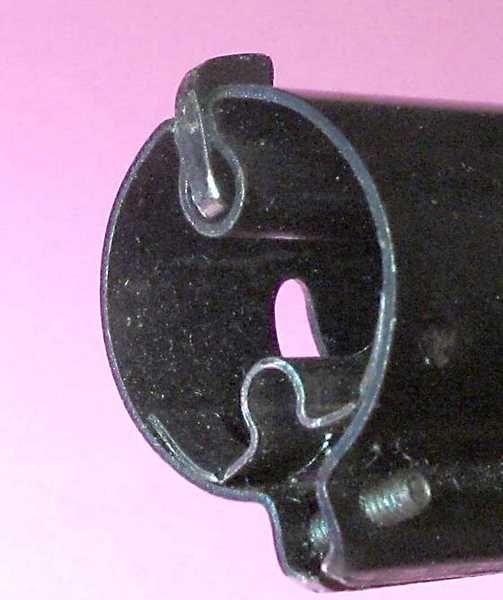
The rails are just folded metal attached to the inside of the pistol frame. The top rail where you see the front sight doubles as the shot magazine.
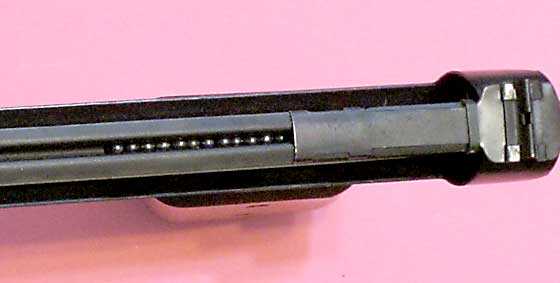
Looking down on the top of the pistol we see the shot magazine. It’s gravity feed. I showed this in Part 1 but the picture wasn’t that clear.
Velocity
Now I’m going to get into the velocity test of one of my own Sharpshooter pistols. Because each pistol is unique, I will try to do all or most of the testing on one gun. We will call this gun the wooden-handled pistol.
We will begin by establishing a baseline velocity. Fletcher used up to five rubber bands on one gun in his tests, and, like I told you, more bands don’t always increase velocity. And there is something else to consider. There is limited space in the launcher for the rubber band to pass through. That’s one more limit on what you can do.
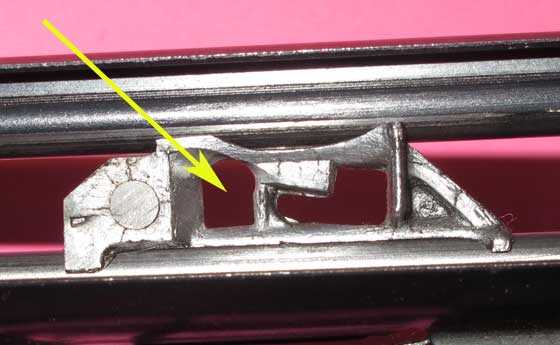
The hole for the rubber bands (arrow) limits the number of bands that can be used. The hole behind that one (on the right in this picture) won’t work because the bands will eventually rip out the thin zinc post between the two holes.
One band
I will start testing with one band. And as I said, there is no need for a 10-shot string. One shot is really all it takes. But I will take two shots this first time to demonstrate.
Shot………Velocity
1…………….61
2…………….60
Satisfied? Okay, that was less velocity than I anticipated. I then removed the large fat band that was also too long and replaced it with first one and then two of the thinner, shorter bands.
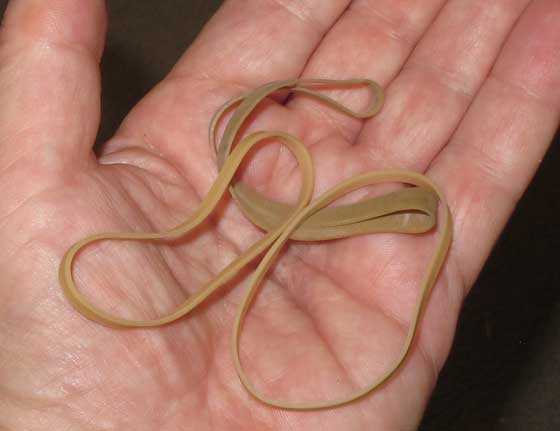
The one fat rubber band that’s curled up in this picture was replaced by one and then two of the smaller bands that lie on top.
Chronograph problems
Before I do that, though, let me tell you about the problems I had with the chronograph. Indoors it would not register these number 6 shot at all. The skyscreens are just not up to the job. The shot is less than .12 caliber in size and it is moving incredibly slow — two things that will stress your machine. I didn’t feel like setting up my Oehler 35P that always registers, so instead I took the Chrony outside.
The day was totally overcast, giving the skyscreens a bright gray background to look at. Almost every shot registered after that, including the two shown above. Now I’m ready to tell you about the two smaller rubber bands.
The fat band came off. Then one small band on the gun gave 82 f.p.s., which is an increase of 21 f.p.s. over the fat band. Two small bands gave 121 f.p.s., a boost of another 39 f.p.s. But two bands made the gun hard to cock. I may try it with more, but for target shooting, two is my limit.
These are fresh rubber bands that have never need used before. That’s something that has to be taken into account.
Discharge sound
I cannot detect any sound when the gun fires. I hear the shot hitting its target, but even that is quiet. This is a gun you can shoot anywhere without alarming anyone.
Trigger pull
The trigger pull changes with the strength of the rubber bands. I didn’t measure it but it went from around 3 lbs. to over 6 lbs. in today’s test. That’s another reason for not adding more bands.
Accuracy
Accuracy? That’s not today! It’s not even next time, because we have more velocity testing to do. But I couldn’t resist taking one aimed shot. Suffice to say that if my target was a housefly, I would have got him!
Next time
Like I said I plan to test velocity more next time. The ammo stays the same but the number and type of rubber bands changes. And I also have another experiment to conduct that I hope will boost velocity without adding more bands. See if you can guess what it might be.

B.B.,
Boosting velocity without adding more bands? Either lighter ammunition or more tension by placing the ends of the bands not at the front posts but at the screw at the front probably. Maybe a little moly grease can help too. Didn’t realize that the carrier was guided not only below but also on top.
Thanks for the close-up and illustration of the cast metal carrier. It looks doable as a 3D printed part. You just have to find somebody capable of translating the part into something that can be printed.
Siraniko
BB
That was a good letter you posted for the feild target shooter.
Definitely a bunch of good points brought up.
G’day BB
A fine steel spring that pulls out like an elastic band?
Cheers Bob
Bob,
The fine coiled springs I just tried have a lot more mass than a rubber band of (about) the same resistance and a much slower recovery rate. Think that the performance would be very poor.
Hank
hank,
Glad to hear you finally did the Maximus trigger mods.. I will bet that you are much happier and wish that you would have done it sooner? The Granddaughter might think it is better as well,… I would think.
I have mentioned this before, but for more pellets at the ready,… I took a chunk of very firm foam, custom cut it to wedge just ahead of the front mount. Drilled small holes clear through in 3 spots (for a cut off tooth pick). The other side got drilled slightly bigger to accept a pellet and the pellet will sit flush and 100% protected. When the pellet is fully in, the toothpick sticks out about 1/8″ on the opposite side. Need another pellet?,…… push on the toothpick and pluck out your pellet. VERY nice!
Chris
P.S.,….. This would work with (any) single shot pellet gun that is scoped ya’ all.
Chris,
Like the pellet-holder idea, would be very convenient.
I use a stiff-leather pellet pouch with a special spill-proof flap when I am on a walk-about. I can carry a bunch of pellets without them getting damaged and can easily pluck one out to load. Made that pouch when I was a teenager and it is still serviceable. I recently bought some leather to make another one for my granddaughter.
Cheers,
Hank
Some of the garden kneeling mats/pads that most would consider to be (very) firm,… is about what I used. I got my stuff from work. It came in to separate heavy, painted parts during shipping.
B.B.,
Very interesting. Like Bob, I thought of using tension springs (2), 1 per side with a V spring holder made from something like a paper clip at the carrier. Finding the “perfect” springs might prove a challenge though. Sorry, just the modder in me coming out! 😉 Looking forwards to what you come up with. Siraniko’s idea of lubing in some key places sounded pretty good to me.
Interesting lighting on the shots (purple looking, but did quite well). Not a photographer myself.
Nice letter from the PA Cup participant. I am a bit confused as I thought the events were sold out,.. not allowing for walk-ins at the last minute. I guess not. And yes, the letter hit home with me. My travel would be somewhere around 2 hrs. I am always eager for new advice on how to improve my shooting.
Good Day one and all,…… Chris
Chris,
The Cup was sold out. We had a few no-shows that left some spots open. The gentleman in question showed up and asked if we could squeeze him in, which we were happy to do considering the no-shows.
Next year, my suggestion would be to sign up early. Even I was surprised at how fast the Cup filled up this year.
Thanks
Tyler
Tyler,
Thanks for explaining that. I wondered myself.
B.B.
Tyler,
Thank you for the response. Lucky him. That took some real guts with a new gun and not even expecting to shoot at all.
Chris
B.B.,
I have been fascinated by these ever since I first learned of them — through a mere mention of them included in a report you did a long time ago.
Coincidentally, the very first BB gun I coveted as a very young boy was the Daisy 179, a catapult pistol. I wasn’t able to own one then, but I bought one a while back. It probably shoots slightly slower than “179,” probably about 160 fps.b but because I can see the entire flight of the BB, I know that it shoots straight as can be. (And because the 179 is a 4 3/4 inch model, from ten feet away it looks more cool than my Umarex Colt artillery model Colt SAA!)
Thanks for covering these sharpshooter pistols in depth. I am eager to see how accurate they are.
Michael
B.B.
How did Fletcher and Dr. Bunten measure their velocity figures in the 1920’s?
The fellow who wrote you is exactly right, you will learn a lot by going to one of these shoots/matches. People are unbelievably helpful and knowledgable.
-Y
Yogi,
Dean Fletcher is our contemporary and no doubt owns a chronograph. I don’t think Dr. Brunten measured velocity.
B.B.
Cool little pistol!
B.B. Thanks for posting the graphic and detailed pictures – I just added one of these to the “project list”
Hank
BB,
Very interesting report so far – there is a surprising amount of complexity in such a simple pistol.
As far as boosting the velocity without more bands: maybe a little graphite on the rails?
Paul
Paul,
Very good! Actually I plan to use powdered moly. Not moly grease, as that would slow it down — moly powder.
B.B.
Hey B.B.,
You may have mentioned it before on a another report,
but what is the weight, in grains, of a single #6 lead shot?
Obviously, this gun is not a powerhouse. =>
Thanks; take care,
dave
Dave,
They weigh 1 to 1.2 grains.
B.B.
Wow! That’s really light! Thank you.
So, at 121 fps, we are talking an energy of 0.04 fpe…not huge, but I think it would take out that house fly. =>
Thedavemyster,
Look at the edge of the right hand box. It even promises you that it is “HARMLESS”.
Half
Hahaha, thanks, man! I missed that somehow…”Harmless”…that’s cute. =)~
BB,
I think you mentioned that the sled was eventually made from plastic. Do you think that gave a higher velocity? I’d also like to know if the lead shot just rides up into it’s launch position as the shuttle comes forward and the ball’s inertia holds it in place, horizontally, until its upward motion on the ramp is restricted and it has no chose but to fly forward with the shuttle. If that is how it works, it is genius in its simplicity. I can’t say that I understand the transfer of the shot from magazine tube to launcher or how the launcher is held in place or released buy the trigger. Got anymore pictures?
Half
Hey John,
Did you notice that Pyamyd Air has a single shot tray made by Air Venturi for the Urban?
I know that the lack there of was a concern for some considering a purchase of the Urban.
/product/air-venturi-single-shot-magazine-for-bsa-gamo-pcp-air-rifles?a=8798
Geo
Geo,
Thanks for sharing that. I don’t know that I need one though. I have 3 mags total and they feed fine and I don’t think single loading will make any difference for me, accuracy-wise. It also looks like a very simple DIY project in wooden form 😉
Half
Half,
You have it. That is how this gun works.
The shot dropping and how the sear holds the launcher are hidden by the launcher, but the movement of the sear upward during cocking opens the hole for one ball to drop, then it closes the hole afterward. The launcher has been pulled into position at this point so the ball drops into the seat for launching. The launcher is what moves the sear when the launcher is pulled back.
I have just looked at the launcher and cannot see how to show this to you in photos. You really need to see it for yourself.
B.B.
I’d like to see it tested with some of the elastics that we rely on in the slingshot world, such as medical latex, dankung tubes, GZK rubber, etc. There are also some fringe types who swear by the red office rubber bands for velocity. Sticking with your current rubber bands, and assuming an optimal 5.5:1 stretch ratio, I’d say that the only way to pick up velocity (with the same ammo) would be to lighten up the sled.
Too bad they didn’t make a version for .22cal lead balls…
Interesting gun/series…Thanks for sharing!
My youth experience with catapult guns (never knew that was the name) involved cutting rings out of inner tubes. Longer the “barrel”, larger the tube diameter. Empirical research showed natural rubber vastly superior to synthetic rubber. Red bands were much more powerful than black ones. Width of the band was important both for longevity as well as power. Tying knots in the bands was a favorite technique to increase the tension. Early power adjuster, I guess. Memories of a mis-spent youth – anyone else?
Thank’s Tom for sharing my experience at the 2018 Pyramid Air Cup. In all my 39 years of shooting springers on and off I would have never guessed such a sport would have ever manifested. Since the PAC I’ve really improved my preparation. Yesterday I meticulously created a Range Card with a lighter pellet. I went from JSB 10.3 gr to JSB 8.33.. Wow! What a difference learning exactly pellets drop per yardage for a specific pellet makes. This may seem mundane to most here but for me it’s a game changer. I can hardly wait for my next chance to compete. I can see myself someday being actually competitive. Does anyone here know of any upcoming competitions in HFT in the midwest or south or central eastern U.S? I’m from Central Indiana.
Springer,
Welcome to the blog
B.B.
Thanks Tom. I’m now wanting to follow your advice and adjust the trigger on my TX200. I took the assembly off the stock to take a peak at the trigger screws. I see the Trigger Resistance Spring Screw is locktited on. How much should I back out the screw to see a difference and do I need to relocktite it back in after I’m done? Thanks again! Steve
Steve,
I would follow the directions in the manual and get the trigger like I prefer it.
Locktite only means that once the trigger is adjusted it won’t change. It isn’t there to prevent adjustment.
B.B.
Springer Fan,
Welcome too! Stick around,…. it only gets better! 🙂 Also,… feel free to post (anything) on the current blog. Off topic can be, (is often), the norm. 😉 The (current) blog will get you the most responses. If you are seeking info.,…. the Fri. blog is best,.. as it stays up 3 days.
A serious “hat’s off” to you being new and getting in there with the “big guns”!!!!!! That is more than I have done! Well done Sir!
Chris
Thanks Chris, Yes I am very excited that I can see the light at the end of the tunnel so to speak. I’m really loving this TX200. It has so much capability. I have not chronoed the JSB 8.44 pellets I’ve switched to but using Hawkes App I think I’m shooting something like 960 FT per second. That’s hauling ass! At 55 yrs my holdover is only 2 inches. To me that’s amazing. Also I bought a FFP Scope when I bought my TX200 from Pyramid and I must say why would anyone in HFT buy anything but a FFP scope? I’m sighting in at 24 power to really refine my hold-over. And nothing changes when I go back to 16 power. Cool!
Springer Fan,
🙂 x 10. My first air gun a few years ago was a .22 TX200. Yes, they are very nice. I also had a .22 Walther LGU. I adjusted the triggers on both, but forget what I did as I do not have them anymore.
You see,… I hung around here a wee bit too long and got bit by the PCP bug real bad! It happens. Both the TX and LGU went to readers here.
On scopes, I too just bought the Athlon FFP 8-32 x 56 and just love it. The holdovers remain the same through all magnifications (which is the point). I commonly use 24x.
Best wishes going forwards and look forwards to hearing more from you.. (current blog),… 😉
Chris